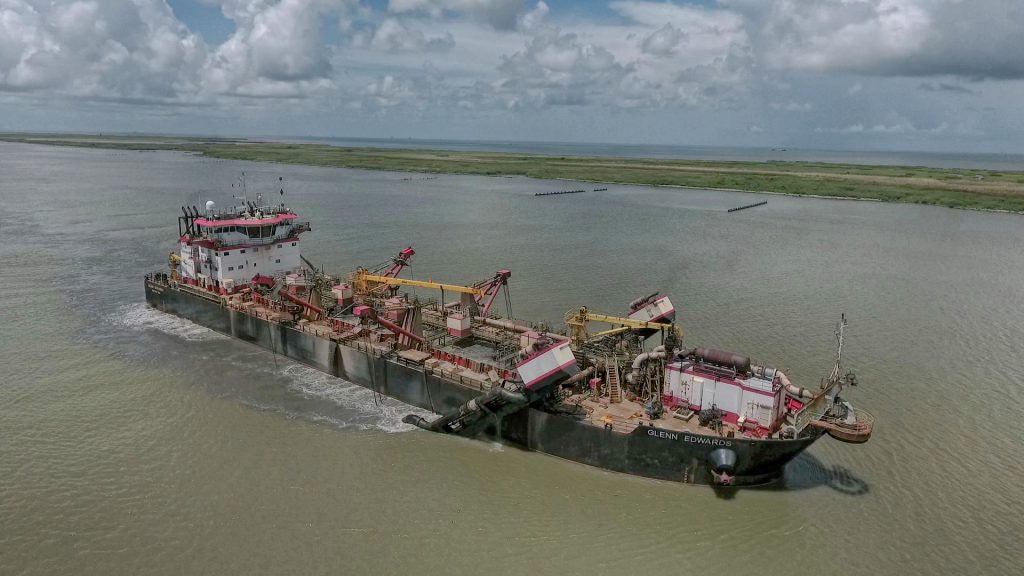For the last two years, economists Brent Gloy and David Widmar have carved out time each spring to...
Efforts to Deepen Mississippi River Can Increase Net Incomes of Soybean Producers

A deeper river will allow both larger ships to be utilized and current ships being used to be loaded with more revenue-producing freight. Average vessel loads will increase from 2.4 million bushels of soybeans (66,000 metric tons) to 2.9 million bushels (78,000 metric tons) – a 21% increase or 500,000 bushels.
A dredging project supported through soybean farmer checkoff investments and a state-federal cost-share is making progress toward expanding marketing opportunities for U.S. soybean farmers.
While work to deepen the lower Mississippi River from 45 feet to 50 feet officially began in 2020, December 2021 announcements from river pilot associations put the project back in the spotlight. Mike Steenhoek, Executive Director of the Soybean Transportation Coalition (STC), said the Crescent River Port Pilots Association increased its maximum draft recommendation to 48 feet. The association represents the pilots responsible for ocean vessel transit between Southwest Pass (River Mile 1.9 Above Head of Passes [AHP]) and New Orleans. Southwest Pass is the shipping channel at the southernmost portion of the Mississippi River that empties into the Gulf of Mexico.
The Associated Branch Pilots (the “Bar Pilots”) raised their maximum draft recommendation to 49 feet. The Bar Pilots are responsible for ocean vessel transit between the Gulf of Mexico and Southwest Pass. As a result, the allowable depth for over 150 miles of the lower Mississippi River is now set to 48 feet.
“This progress will take a number of years to complete but seeing the initial 150 miles being opened at a deeper level and some incremental gains being made as a result of that dredging work is very encouraging,” Steenhoek says.
Ultimately, the project calls for a 50-foot channel all the way to Baton Rouge (river mile 232). Therefore, there are 82 miles of deepening remaining until the project is fully completed. This remaining work will likely take 2-3 more years due to the increased complexity of the river at that section, including submerged pipelines under the river, according to Steenhoek.
Benefits to farmers
A study commissioned by the STC illustrated the benefits to farmers of deepening the 256-mile stretch of the Mississippi River from Baton Rouge, Louisiana, to the Gulf of Mexico. This area accounts for 60% of U.S. soybean exports and 59% of U.S. corn exports, the leading export region for both commodities.
Areas with positive or slightly negative basis (or the difference between the local price a farmer receives and the market value established by the Chicago Board of Trade) will expand as the lower Mississippi River is dredged to 50 feet, according to research by Informa Economics IEG. This will result in Midsouth soybean farmers receiving more than $46 million more for their soybean crop per year, Informa predicts.
Research from Informa Economics IEG shows that shipping costs for soybeans from Mississippi Gulf export terminals would decline 13 cents per bushel if the lower Mississippi River is dredged to 50 feet. That’s due to both larger and heavier ships being able to navigate the waters.
The project is expected to help the U.S. maintain its competitive advantage in the export arena. Soybeans were the most widely grown commodity in the Midsouth in 2021, so the deepening of the No. 1 export channel for soybeans will undoubtedly be beneficial.
“It’s an opportune time because we’re expecting to have strong exports and we still operate in a tight margin environment, so any opportunity to improve the economics of our supply chain is going to be beneficial to us,” says Steenhoek.
EDITOR’S TAKE:
The Mississippi river is a major artery for grain shipments in the upper Midwest to the rest of the world. It is a continual battle to stay ahead of Mother Nature when it comes to updating locks and dams or dredging projects. The dredging mentioned in this article is a major undertaking but when completed will serve agriculture well. Lower shipping costs combined with higher prices and, hence, increased farm income, are very positive results indeed. This combination of outcomes can only mean additional money in the farmer/rancher pockets for things like truck purchases.








